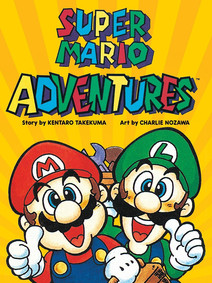Review
by Rebecca Silverman,Super Mario Adventures
GN
| Synopsis: |  |
||
While fixing the pipes in Princess Toadstool's castle, the Mario brothers witness Bowser kidnapping the princess so she can be the mother to his brood of kids! Mario and Luigi immediately take off after them to rescue the princess, but Toadstool's no wilting flower – she ends up needing to rescue them right back. Along the way, they meet Yoshi and a fast-talking salesman named Floyd, then team up to defeat numerous villains from the game, so come along for the ride! |
|||
| Review: | |||
Originally running over the course of 1992 in Nintendo Power magazine, Super Mario Adventures is the second of Viz's large-format, full-color collected editions of the magazine's nostalgic comics. That's really the chief appeal here – the nostalgia force is strong with this book, and while those who missed the days of early modern gaming can still find things to enjoy, especially with Nintendo's recent re-release of the classic system and its original games – this will mostly be a book for those who grew up reading the magazine and being immersed in early Nintendo pop culture. The story doesn't follow any one game but does feature a familiar quest: Princess Toadstool (later Peach) has been kidnapped by Bowser, the dragonesque villain of the Marioverse. Bowser's goal is to make Toadstool his beloved wife and mother to his brood of children, but Toadstool isn't interested in going along with his plans. Since Mario and Luigi witness the kidnapping, they immediately set off after Bowser, jumping into a strange pipe that lands them in a mysterious new land. They quickly hatch Yoshi from an egg that Luigi planned to satisfy his hunger with, and once they realize that he's not going to eat them, the trio sets out to find where Bowser is keeping the princess. Fortunately, Toadstool's not willing to sit around playing Princess in the Tower, so she actively works toward her own rescue and soon finds herself having to save Mario and Luigi. Even without the equality aspects, this makes the book more interesting by throwing in a few plot twists and making Toadstool a real character rather than an object to be rescued; while Mario and Luigi are fun, they couldn't have carried the whole story by themselves. The writing is definitely dated, with no noticeable linguistic updates since the early 1990s. That works for the nostalgia factor, but it may make things less appealing for newer readers. The language is tailored for a roughly middle-grade audience, with a lot of rhyming: when Bowser first enters, he speaks entirely in “rap,” with a set rhythm and rhyme scheme that feels just a little cheesy. Likewise, the first pages of the book are entirely in rhyme as Mario chirps about the Mario Brothers' plumbing prowess. There's a lot of alliteration in general, even when the dialogue isn't in rhyme, which adds to the feeling that the story is skewed for a much younger audience than people who are likely to pick up the book now. On the plus side, this would make a very good gift for a budding young gamer who has just discovered Mario or retro gaming – with its flipped pages and bright artwork, along with the simple vocabulary and rhymed dialogue, this is a good introduction to manga for children in general. And wow is the artwork bright! Everything is done in primary colors with almost no white or black space. Whether this has been retouched from the originals in order to achieve such brightness isn't mentioned, but the kiddy show vibrancy makes the pictures really stand out. Charlie Nozawa's art is simple and somewhat old-fashioned with the look of late '70s/early '80s shounen in its roundness, but given the level of the art to reference in the original Mario games, it works quite well. There isn't a lot of fussy detail in the backgrounds, but this works for the presumed audience and the look of the original games – the world may not be detailed, but it is clearly recognizable. Seeing the characters up close and in such clear color does occasionally make for a disconnect, such as when you realize that Mario and Luigi have brown hair and black moustaches, but for the most part, the art is solid. Super Mario Adventures works best as a trip down memory lane, but it does have potential appeal as an introduction to the Marioverse for young readers as well. The nostalgia factor will make this less interesting for readers without experience in this era of Nintendo history, because the story and the artwork do skew toward the elementary/middle grade crowd. But it's still a fun journey if that's part of your childhood or if you know a kid of the right age to appreciate the jokes and vivid artwork. Mario, Luigi, and Princess Toadstool are fun, friendly characters to spend some time with whether in game format or manga, so grab your favorite cookies and enjoy their adventure. |
| Grade: | |||
|
Overall : B-
Story : B
Art : B-
+ Fun trip down memory lane or for a younger reader, artwork is bright and simple and the story works with all three main characters rather than just the brothers |
|||
| discuss this in the forum (14 posts) | | |||
| Production Info: | ||
|
Full encyclopedia details about Release information about |
||